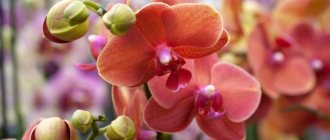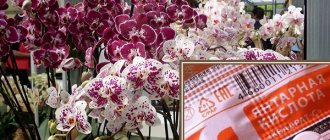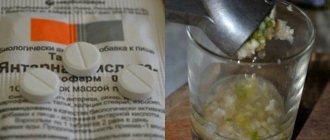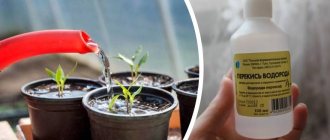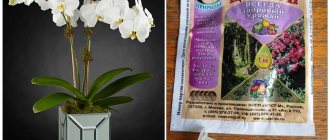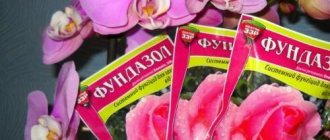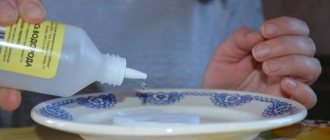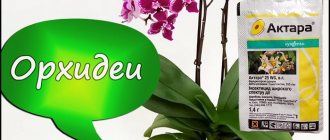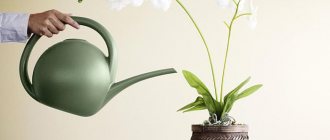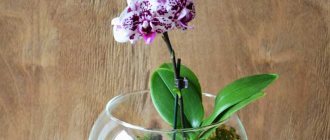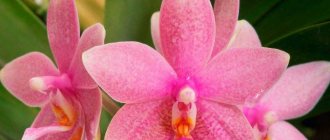Orchids are perennial indoor plants that require special conditions due to their exotic origin. For harmonious growth and lush flowering, this type of green “pet” requires periodic feeding. In particular, it is useful for any gardener to learn how to fertilize orchids with hydrogen peroxide at home. Do not forget that this substance, although seemingly harmless, has the properties of an oxidizing agent, so its use should be reasonable.
What is it, can an orchid be treated with it?
Peroxide is a chemical compound H2O2. It has an asymmetrical structure, undefined oxygen electron pairs. Often used in medicine for treating wounds or disinfecting. It is a popular remedy among housewives; folk remedies are prepared from it for cleaning textiles or hard surfaces.
Flower growers have found in this chemical compound an effective remedy that affects the growth of orchids. Penetrating into living cells, it activates biochemical reactions leading to differentiation and cell growth. Hydrogen peroxide will benefit the flower only with moderate and adequate use.
Attention! H2O2 cannot be treated with an orchid after feeding and watering with copper or iron based products. When interacting with these chemical compounds, a dangerous radical is formed, which will cause the death of biological plant cells.
Main mistakes when using
It is important to dilute the solution correctly
Many people make up a working solution for treating orchids like this: mix 1-2 tablespoons of hydrogen peroxide (3%) with 1 liter of water - but its use makes no sense.
The concentration of the beneficial substance in this case will be 0.01%, which is almost comparable to ordinary water.
Under the influence of light and heat, peroxide slowly but inevitably decomposes. This process can be accelerated by contaminants that accidentally get inside the bottle. Over time, the proportion of peroxide in the container becomes uncertain.
Benefit or harm
Experiments have been carried out for a long time, and there have been many disputes regarding whether hydrogen peroxide is harmful or beneficial for orchids. Some of its advantages include the following:
- soil disinfection;
- cleansing the plant from all types of pests: insects, microorganisms, microbes, mites;
- strengthening the immune system, acquiring a protective reaction to various diseases;
- improvement of flower growth.
There is no harm in using hydrogen peroxide for orchids, since the chemical element is not toxic, and all active substances quickly disintegrate when used. But it will be harmless only with moderate use.
If you frequently feed a plant with hydrogen peroxide, the plant will become overly sterilized, which is why its immune system will no longer develop resistance to the penetration of harmful bacteria and microorganisms.
Purposes of application
Based on useful words, the purposes of using peroxide for orchids are as follows:
- Preventing the entry or elimination of infections or bacteria. The active substances affect every cell of the plant, destroying the fungus or bacteria present on it.
- Oxygen saturation. The chemical element reduces the load on the flower, improves the respiration of the root system and leaves.
Flower growers use a chemical compound of hydrogen to rid the plant of pests, but they are not always able to achieve a positive effect after treatment. It is recommended to choose another method to combat insects, since eliminating them requires a large dosage of this substance, which can be fatal to the orchid.
Hydrogen peroxide for diseases
The drug is used both to combat diseases and for prevention. When replanting, the pot and roots of the plant are treated.
If flowers become exposed to bacteria, infections or pests, a standard solution should be prepared. Dissolve 30 ml of peroxide with 250 ml of water, you can add 10 drops of iodine. This treatment will protect the orchid from mealyworms, small midges, spider mites and scale insects.
If the lesions are large-scale, you need to add medical alcohol. After a week, repeat watering.
If the plant has been exposed to fungal diseases, then add 2 tablespoons of soap shavings to this solution.
The following solution is great for getting rid of scale insects. Add 50 ml of 3% peroxide and 50 g of sugar per liter of water. Water once a week.
Concentration, dilution rules
Highly concentrated peroxide containing 30% active substance must first be diluted with water. The purpose of its use is the disinfection of swimming pools or technical devices. The concentration should be 1 tablespoon of peroxide per 1 liter of water. But it is still not recommended to treat the plant with such a technical means; you should choose a more gentle concentrate.
Important!
Pharmacy hydrogen peroxide has a concentration of 3%. You can water your orchid with it without prior dilution. If a chemical compound is diluted with water, it will completely dissolve in it and be ineffective.
Watering flowers with hydrogen peroxide
To water with hydrogen peroxide, you need to make a solution. Observe the following proportions: dilute 20 ml of 3% per liter of water. When applied to the soil, active oxygen ions are released, which promotes increased aeration. Then it combines with other atoms to form a stable oxygen molecule.
Watering is carried out no more than 3 times a week. It is necessary to use only fresh solution, or it will lose all its properties.
When released, oxygen acts as a leavening agent, nourishing the root system. The growth of seedlings improves. It is recommended to water wilting crops. When sprayed, it gives more oxygen to flowers.
Acceptable processing methods
Many inexperienced flower growers who do not know all the features of the effect of hydrogen peroxide on plant crops use this compound in the form of a solution for watering, fertilizing or spraying orchids. Treat the soil with an aqueous solution containing peroxide or soak the pots before planting the flower to disinfect everything.
Experienced flower growers and gardeners assure that all these methods are ineffective for the plant. In their opinion, the chemical element should be used for the following processing methods:
- rubbing the green leaves of a flower to eliminate infection or bacteria;
- soaking seeds before planting to disinfect them from harmful substances;
- spot treatment of damaged areas using a cotton swab.
But, all these methods of treatment must be carried out only with a pharmaceutical chemical element, the concentration of which is 3%, a highly concentrated technical composition will be destructive for the plant crop, it is better not to use it.
Attention!
Before carrying out the treatment, you must first thoroughly wash your hands with soap, wipe dry, and treat with a disinfectant. Instead, you can put disposable medical gloves on your hands. Bacteria accumulate on the fingers and palms, which can infect the leaves or flowers of the orchid.
Treating seeds with peroxide before sowing
Orchid growers who independently propagate orchids by seeds often use peroxide for pre-sowing seed treatment. This is done as follows:
- immediately before sowing, the seeds are poured with 1-2 ml of undiluted 3% peroxide for 2-3 minutes;
- together with the peroxide solution, the seeds are collected into a pipette or syringe without a needle;
- Together with the solution, the seeds are applied in drops to the prepared nutrient medium.
The main purpose of peroxide in this context is to destroy microorganisms that may be on the surface of the seeds. Since germination takes a long time and under completely sterile conditions, without such treatment mold quickly develops on the nutrient medium, and all efforts go down the drain. But some gardeners note that peroxide also improves the germination of orchid seeds compared to other disinfectants.
The ability of hydrogen peroxide to increase seed germination has not been proven and is classified as a folk myth. However, its disinfectant effect on seed material is obvious and is actively used in the propagation of orchids.
Processing technique
The composition and method of application depend directly on the purpose for which you want to treat the orchid with hydrogen peroxide. Basic methods include wiping leaves, soaking seeds, spot treatments and spraying.
Wiping leaves
You may be interested in: How to care for orchids in a pot after purchase Why the leaves of an orchid wither and how to save it Features of the care and propagation of the Dendrobium Nobile orchid
Wiping the leaves is carried out in order to improve the health of the plant maples and eliminate bacterial or infectious lesions from them. To process it you need to do the following:
- Take a clean cotton swab or a small piece of cotton wool.
- Soak it in a solution of hydrogen peroxide.
- Gently lubricate each damaged leaf with it strictly around the source of infection.
The treatment should be performed once, then observe the behavior of the plant. If the expected benefit does not appear within 7 days, the procedure should be repeated.
Soaking the seeds
To disinfect plant seeds, you must prepare a solution in advance. To do this, you need to dilute 25 drops of hydrogen peroxide with a concentration of 3% in 250 milliliters of water. Pour the solution into a deep bowl, carefully place the plant seeds into it and leave to soak for 30 minutes.
After half an hour, drain the water from the container and fill it with cold running water to rinse each seed with it. The washed planting material should be placed on a kitchen towel or a sheet of newspaper in a cool and dry place. After it is completely dry, it can be deepened into the soil.
Spot treatment
Spot treatment is carried out with the aim of healing the plant; the impact is carried out on the source of infection or bacteria. To do this, you need to pour it into a container with a spray bottle; a container for a medical or cosmetic product is suitable for this. Hydrogen peroxide needs to be sprayed onto the lesion at a short distance from the leaf. If there is no special container with a sprayer, then a similar action can be performed using a cotton swab.
Spraying
To rid the plant of disease or pests, you can prepare a fertilizer based on hydrogen peroxide. For this purpose the following components will be required:
- hydrogen peroxide – 30 grams;
- water – 0.25 liters;
- iodine – 40 drops.
Iodine and hydrogen peroxide must be dissolved in water and the entire contents must be thoroughly mixed until all active components are completely dissolved. The resulting fertilizer needs to be sprayed or watered on the plant. Next, you need to monitor its condition; if necessary, you need to repeat the processing again. If a lot of pests have accumulated on the flower, then you can add a few drops of medical alcohol to the solution.
There is a version that a plant can be treated with a solution of hydrogen peroxide to stimulate its flowering. In fact, this chemical element does not have such properties, so it is not used to increase the number of flowers and accelerate their appearance.
Attention!
The undiluted solution can only be sprayed, watered the plant or wiped the leaves. But they cannot process sections. It is also worth preventing its contact with flowers and buds, and leaf axils. It is not recommended to use hydrogen peroxide on a plant in sunny weather, as it may cause burns on the leaves.
Precautionary measures
Peroxide reacts chemically with copper and iron ions, forming substances harmful to plants. Therefore, peroxide should not be used together with copper and iron-containing preparations:
- Bordeaux mixture;
- iron sulfate.
It is not advisable to mix peroxide with biological solutions such as phytosporin, because beneficial bacteria will be destroyed.
Frequent use of peroxide leads to a decrease in the flower's immunity due to suppression of the growth of its protective microflora.
When working with peroxide, the following precautions should be observed:
- minimize the time of exposure of the drug to the plant;
- do not allow the solution to linger in the leaf axils;
- prevent it from getting on buds and flowers;
- sunlight, decomposing peroxide, creates a dangerous concentration of free oxygen in the solution; this should be avoided.
The main thing is that when growing orchids, no critical situations arise, and follow the rules for caring for them.
Is it possible to overdose
Orchid and hydrogen peroxide are a very successful combination, but only if you use the chemical element in moderation. But this issue is controversial, since peroxide tends to disintegrate in water. Accordingly, it becomes obvious that an overdose of this substance in dissolved form is impossible.
But if the treatment is carried out with undiluted peroxide, then the orchids can be damaged, even to the point of destroying the root system. The same effect will occur when using technical 30% hydrogen peroxide as a top dressing or fertilizer. Another possible harm is a weakening of the immune system, to the point where the plant loses protection against infections and bacteria.
Current questions about the use of peroxide for orchids
Question No. 1. The orchid's roots were rotten and I had to trim a lot. Is it possible to rinse the remaining root system in peroxide?
There is no need to rinse the roots entirely. This will be equivalent to completely immersing a cut hand in peroxide. The only thing that makes sense to do is to process the sections themselves. But in such a situation it is much better to use other means - potassium permanganate or a fungicide solution. The diseased orchid is immersed in them with the remaining roots for 5 minutes, after which it is dried.
Reviews from flower growers
Irina
I have been growing orchids for more than 5 years, during which time I have repeatedly encountered the fact that this plant is susceptible to various diseases, including insects. For all types of lesions, I treat the leaves with hydrogen peroxide. But, I recommend slightly moistening the cotton wool and making several movements around the affected surface. If you overdo it, the effect will be the opposite.
Marina
Yes, indeed, hydrogen peroxide works well against pests and bacteria. I once used it as a fertilizer, but did not notice a positive effect. Then, an experienced gardener explained to me that for good orchid growth, nitrogen, phosphorus, microelements and macroelements are needed. Of course, none of this is contained in peroxide.
Expert opinion
Experts in the field of floriculture have a controversial opinion about the effects of hydrogen peroxide on orchids. Some of them claim that it is absolutely useless, others say that a positive effect is still observed from it. It was possible to come to the conclusion that it is really useful if it is not diluted with water and used in moderation.
Expert Oksana Nikolaevna
Peroxide will become an essential helper if the flower has not been properly cared for. It will eliminate all infections, pathogenic substances and prevent the occurrence of viral or infectious diseases. But, it is not used to eliminate pests and saturate the plant with nutrients.
Hydrogen peroxide is a non-toxic chemical compound. That is why it can be used to treat even such capricious plants as orchids, but the dosage must be observed.
How to feed the plant so that it blooms blue?
How can you treat an orchid to make it blue? Need to remember! There are no blue orchids! If one is sold in a store, then it is most likely white, simply painted with a chemical dye that will wash off over time.
For the first time, blue phalaenopsis was presented at an exhibition in the USA in 2011. Then, a few months later in Holland, the famous nursery "Geest Orchideeën" presented to the public Phalaenopsis Royal Blue, colored using a patented technology.
This dye is natural and does not harm the plant. The secret of this technology is not disclosed. But many sellers, wanting to make good money and not caring about the health of the orchid, try to paint it the desired color without any technology. Most often this is simply an injection of ink or blue into the stem or root of a plant. After purchasing the orchid, it may simply die.
Japanese breeders have bred the only truly blue species of orchid by introducing the blue-eyed gene, but, unfortunately, it is not commercially available.
If you still really want to try “coloring”, it is better to use food coloring. Dissolve the paint in water for irrigation. The richer the color of the water, the brighter the color of the plant. The procedure is simple, but not very effective and not durable.
If you stop watering the dye, the orchid will return to its original color. Flower growers recommend using water in which aluminum alum was soaked for safe coloring. The injection is more effective, but the damage to the plant is enormous. Most likely it will get sick and require constant care.
You need to think carefully about whether it is worth subjecting the orchid to such tests for the sake of temporarily changing the color of the orchid.

